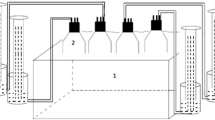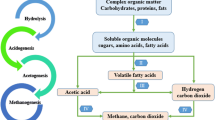Summary
Batch anaerobic digestion of water hyacinth (Eichhornia, crassipes) was carried out in the laboratory. Daily gas yields were 18.9, 20.8. and 27.0 l/kg total solids (TS)/day for feedstocks containing 50, 30 and 20 g TS/l, respectively. Percentage decomposition rates of organic solids were 70.1, 72.0 and 75.6 for the 50, 30 and 20 g TS/l slurries, respectively Differences in methane content of the biogas were negligible. The average biogas produced per kg TS was 631 l. Three types of inoculum were used to start digesters freshly charged with 50 g TS/l of water hyacinth slurry: digested domestic sewage sludge (DSS), sheep rumen liquor (RL) and sludge from an old digester working on water hyacinth (WHS). The digester seeded with WHS gave the highest yield of biogas per kg dry water hyacinth, viz. 552 litres. The unseeded control gave only 221 litres/kg. Decomposition of volatile solids was 71.9% for the WHS digester and only 35.0% for the unseeded digester. The DSS and RL digesters gave results between these extremes with respect to both gas yield and percentage utilization of volatile solids.
Résumé
La biométhanisation de la jacinthe d'eau (Eichhornia crassipes) a été conduite en milieu non renouvelé (batch) et à l'échelle du laboratoire. On a obtenu des vitesses de production de 18.9, 20.8 et 27.0 litres de gaz par kg de solides totaux (TS) et par jour pour des liqueurs mixtes contenant initialement respetivement 50, 30 et 20 g de TS par litre. La conversion des solides volatils (matière organique) était respectivement de 70.1, 72.0 et 75.6% pour les liqueurs mixtes contenant initalement 50, 30 et 20 g de TS par litre. Les différences en contenu en méthane du biogaz étaient négligeables. La quantité moyenne de biogaz produite par kg de TS était de 6311. Trois types d'inoculum ont été utilisés pour démarrer les digesteurs qui venaient d'être chargés par un broyat de jacinthe d'eau à 50g de TS par litre: la boue digérée de station d'épuration d'eau résiduaire domestique (DSS), la liqueur mixte du rumen, de mouton (RL) et la boue d'un digesteur alimenté dequis longtemps par la jacinthe d'eau (WHS). Le digesteur ensemencé avec l'inoculum WHS a donné le meilleur rendement en biogaz par kg de jacinthe sèche: 5521. Le contrôle sans ensemencement n'a donné que 2211 par kg. La conversion en solides volatils était de 71.9% pour le digesteur ensemencé avec l'inoculum WHS, tandis qu'elle n'etait que de 35.0% pour le digesteur non ensemencé. Les digesteurs ensemencés soit avec l'inoculum DSS soit avec l'inoculum RL ont donné des résultats intermédiaires entre ces deux extrêmes tant pour le rendement en biogaz que pour la conversion des solides volatils.
Resumen
La digestión anaerobia semi-continua de jacintos acuáticos (Eichornia crassipes) se realizó a escala de laboratorio. Los rendimientos en gas fueron de 18.9, 20.8 y 27.0 l/kg de sólidos totales (TS)/día, y las velocidades de descomposición de sólidos, yolátiles, expresadas en porcentajes, fueron de 70.1, 72.0 y 75.6, ambos parámetros relativos a producto inician con un contenido en sólidos totales de 50, 30, y 20g TS/l respectivamente. La cantidad media de biogás generada por KG TS fue de 6311. Se utilization tres tipos de inóculo para iniciar la fermentación en digestores recién cargados con pasta líquida de jacinto acuático: fangos de depuradora doméstica (DSS), extracto de rumen ovino (RL) y residuos de pasta de jacinto ya fermentada (WHS). El digestor sembrado con WHS fue el que produjo mayor cantidad de biogás por kg de materia seca: 552 l; el digestor sin inocular produjo tan solo 221 l/kg. El porcentaje de sólidos volátiles fue de 71.9% para el digestor con WHS y de 35.0% para el control no inoculado. Los digestores con DSS y RL dieron resultados intermedios tanto para la produccción de gas como para la utilización de sólidos volátiles.
Similar content being viewed by others
References
Anon. 1967/68 Studies on water hyacinth. In 15th Annual Report, Hydrobiological Research Unit, University of Khartoum, Sudan. pp. 14–17.
Anon. 1975Official Methods of Analysis, 12th edn. Washington, D.C.: Association of Official Analytical Chemists.
Anon. 1976Making Aquatic Weeds Useful. p. 110. Washington, DC.: National Academy of Sciences.
Anon. 1979 Information/56, 27th September. p. 1. UNEP.
Bock, J.H. 1969 Productivity of water hyacinth,Eichhornia crassipes (Mart.) Solms.Ecology 50, 460–464.
Bremner, J.M. &Keeney, D.R. 1965 Steam distillation methods for determination of ammonium, nitrate and nitrite.Analytica Chimica Acta 32, 485–495.
Bryant, C.B. 1975 Survey on the Nile River hyacinth problem. Report to the GTZ Sudanese German Water Hyacinth Project, Khartoum (unpublished).
Buswell, A.M. 1954 Fermentation in waste treatment. InIndustrial Fermentations, Vol. 2. ed. Underkofler, L.A. & Hickey, R.J. pp. 518–555. New York: Chemical Publishing Co., Inc.
Chalmers, M.I. 1968 Mission report on animal nutrition in Sudan. InAnimal Production WFP. Rome: FAO, Acc. No. 02787-68-WS.
Dhahiyat Y., Siregar, H., Indiyati &Salim, F. 1984 Studies on the usage of water hyacinth as biogas energy resource in the Dam of Curug (west Java). InWater Hyacinth, ed. Thyagarajan, G. pp. 604–614. Nairobi: UNEP.
Gay, P.A. 1958Eichornia crassipes in the Nile of the Sudan.Nature, London 182, 538–539.
Guha, B.R., Bandyopadhyay, T.K. &Basu, S.K. 1984 Fuel gas from water hyacinth. InWater Hyacinth, ed. Thyagarajan, G. pp. 615–623. Nairobi: UNEP.
Haider, S.Z., Malik, K.M.A., Rahman, M.M. &Ali, M.A. 1984 Kinetics of gas formation from water hyacinth biomass. InWater Hyacinth, ed. Thyagarajan, G. pp. 489–489. Nairobi: UNEP.
Hammerton, D. 1965/66 White Nile survey. In 13th Annual Report, Hydrobiological Research Unit, University of Khartoum. pp. 9–11.
Kormi, I. 1985Biogas. A review prepared for the UNDP Energy Office.
Laura, R.D. &Idnani, M.A. 1971 Increased production of biogas from cow dung by adding other agricultural waste materials.Journal of the Science of Food and Agriculture 22, 164–167.
Lavkulich, L.M. 1978Soil Organic Matter Titrametric Methods. pp. 42–45. Vancouver: Department of Soil Science, University of British Columbia.
Maramba, S.F.D. 1978Biogas and Waste Recycling: The Philippines Experience, Maya Farm Division. Liberty Flour Mills, Inc., Metro, Manila. pp. 21–36.
McCarty, P.L. 1964 Anaerobic waste treatment fundamentals. III. Toxic materials and their control.Public Works 95, 91–94.
Mukhtar, A.M.S. 1967 A preliminary study on the chemical composition of water hyacinth (Eichhornia crassipes), in the Sudan.Sudan Journal of Veterinary.Science and Aniamal Husbandry 8, 124–126.
Omar, K.I. &Farooq, S. 1984 Growth and fermentation studies of water hyacinth biomass. InWater Hyacinth. ed. Thyagarajan G. pp. 474–488. Nairobi: UNEP.
Philipp, O. 1978 Some prospects for the utilization of water hyacinths (Eichhornia crassipes) on the White Nile and its tributaries as future source for energy. First Energy Conference, Khartoum. (Unpublished).
Philipp, O., Koch, W. &Koser, H. 1983 Utilization and Control of Water Hyacinth in Sudan. pp. 58–64. Eschborn.: German Agency for Technical Cooperation (GTZ).
Pirie, N.W. 1968 The present position of research on the use of water hyacinth (Eichhornia crassipes). InHandbook of Utilization of Aquatic Plants. FAO, Rome. pp. 7–8.
Sarker, H., Haque, K.A., Alam, A.K.M.K. &Islam, R. 1984 Biogas from water hyacinth and cow dung. InWater Hyacinth, ed. Thagarajan, G. pp. 500–506. Nairobi: UNEP.
van Velsen, A.F.M. 1977 Anaerobic digestion of piggery waste. I. The influence of detention time and manuare concentration.Netherlands Journal of Agricultural Science,25, 151–169.
van Velsen A.F.M. 1979 Anaerobic digestion of piggery waste. II. Start-up procedure.Netherlands Journal of Agricultural Science 27, 142–152.
Wolverton, B. &McDonald, R.C. 1976 Don't waste waterweeds.New Scientist 71(1013), 318–320.
Wolverton, B., McDonald, R.C. &Gordon, J. 1975 Bioconversion of water hyacinths into methane gas: part 1. NASA technical memorandum, TM-X-72725. NASA, Bay St. Louis, U.S.A.
Zeikus, J.G. 1982 Microbial intermediary metabolism in anaerobic digestion. InAnaerobic Digestion 1981, ed. Hughes, D.E. et al. pp. 23–25. Amsterdam: Elsevier Biomedical Press.
Author information
Authors and Affiliations
Rights and permissions
About this article
Cite this article
Dirar, H.A., El Amin, H.B. Methane fermentation of water hyacinth: effect of solids concentration and inoculum source. Mircen Journal 4, 299–312 (1988). https://doi.org/10.1007/BF01096135
Received:
Accepted:
Issue Date:
DOI: https://doi.org/10.1007/BF01096135




